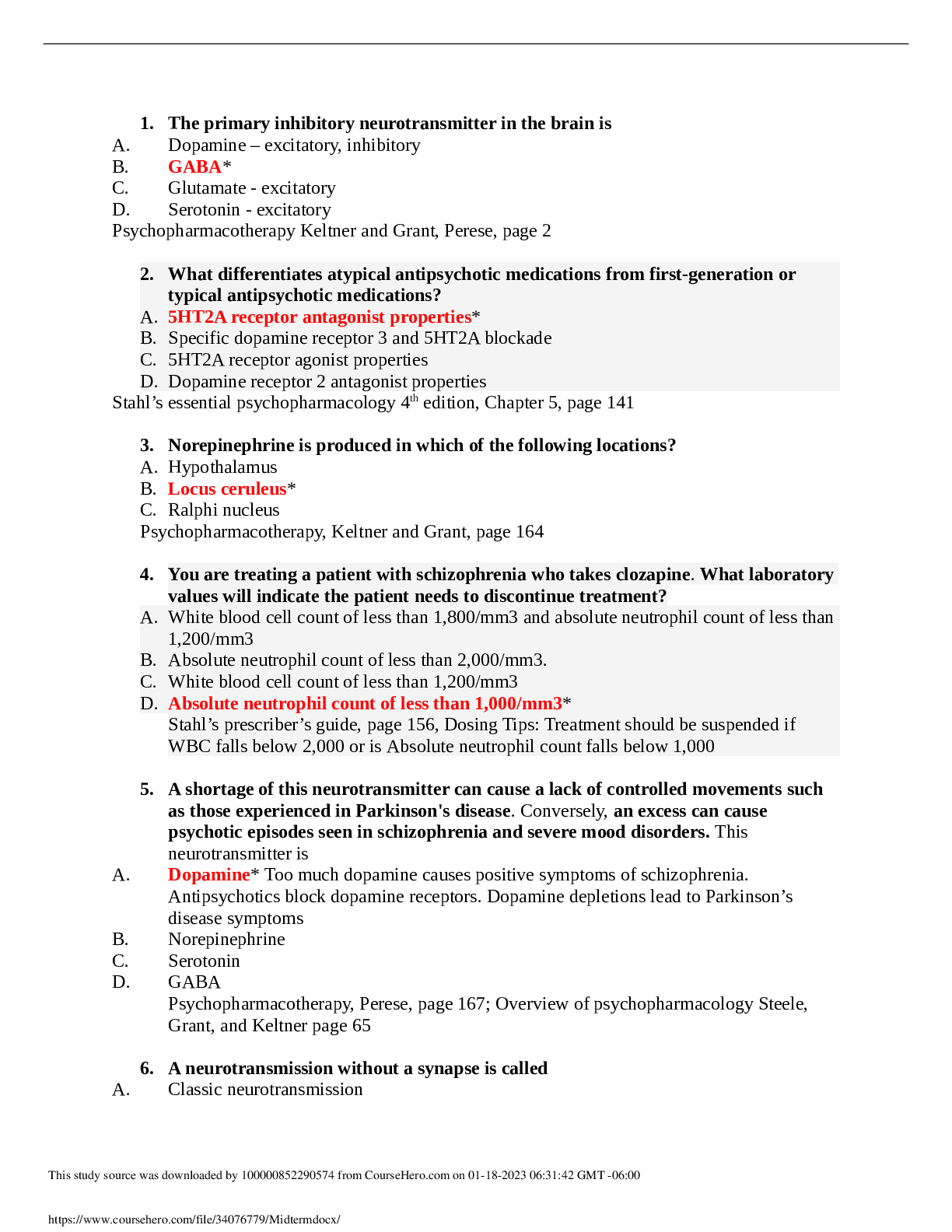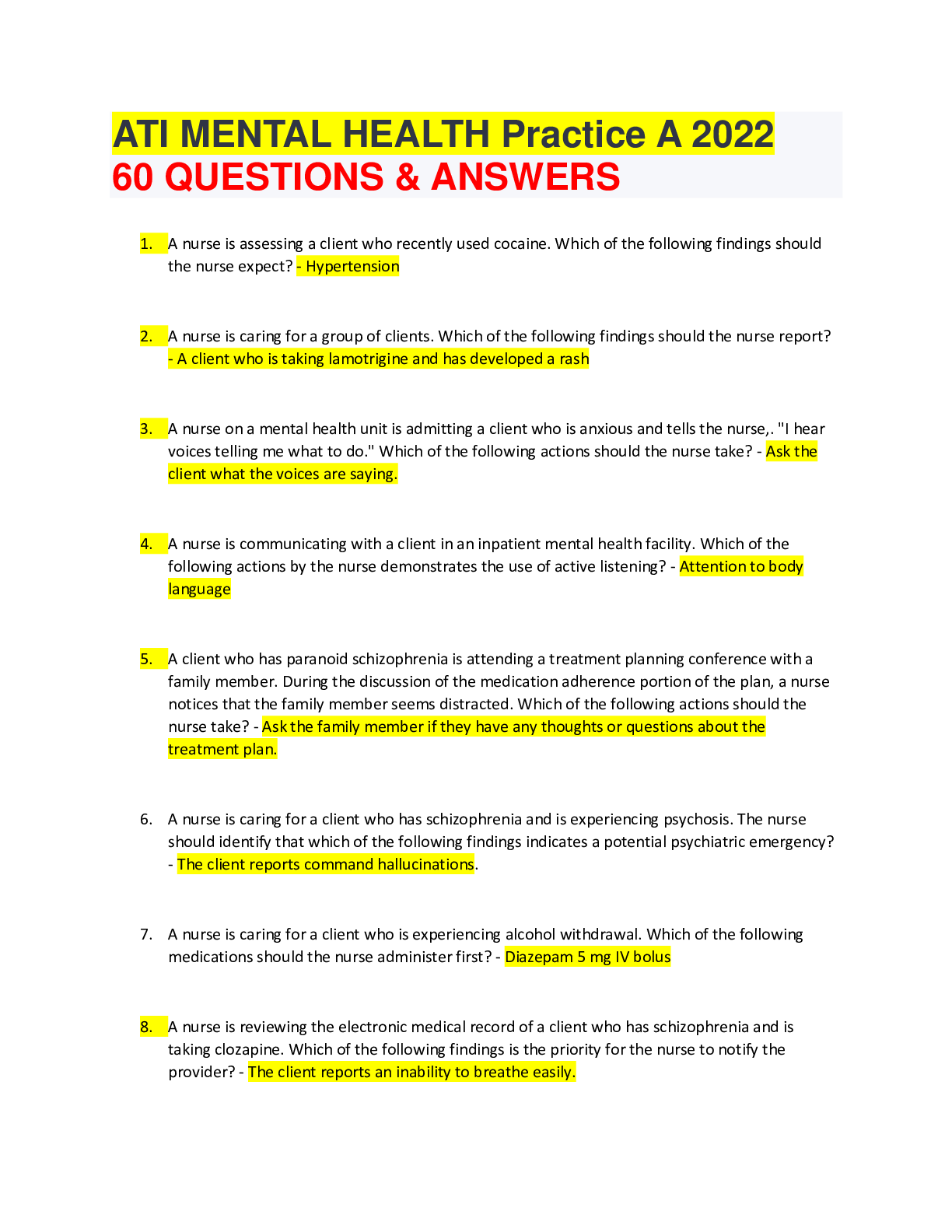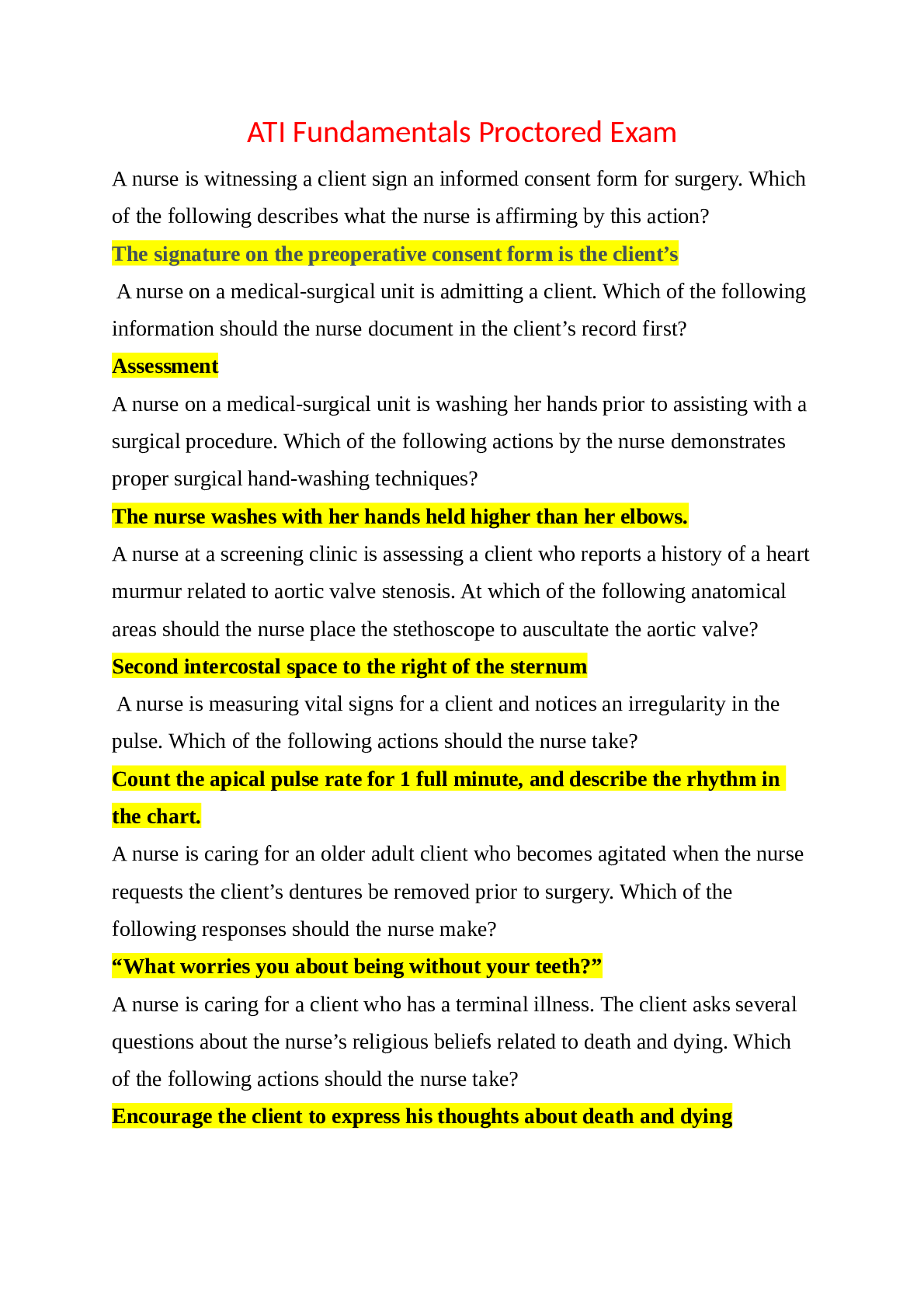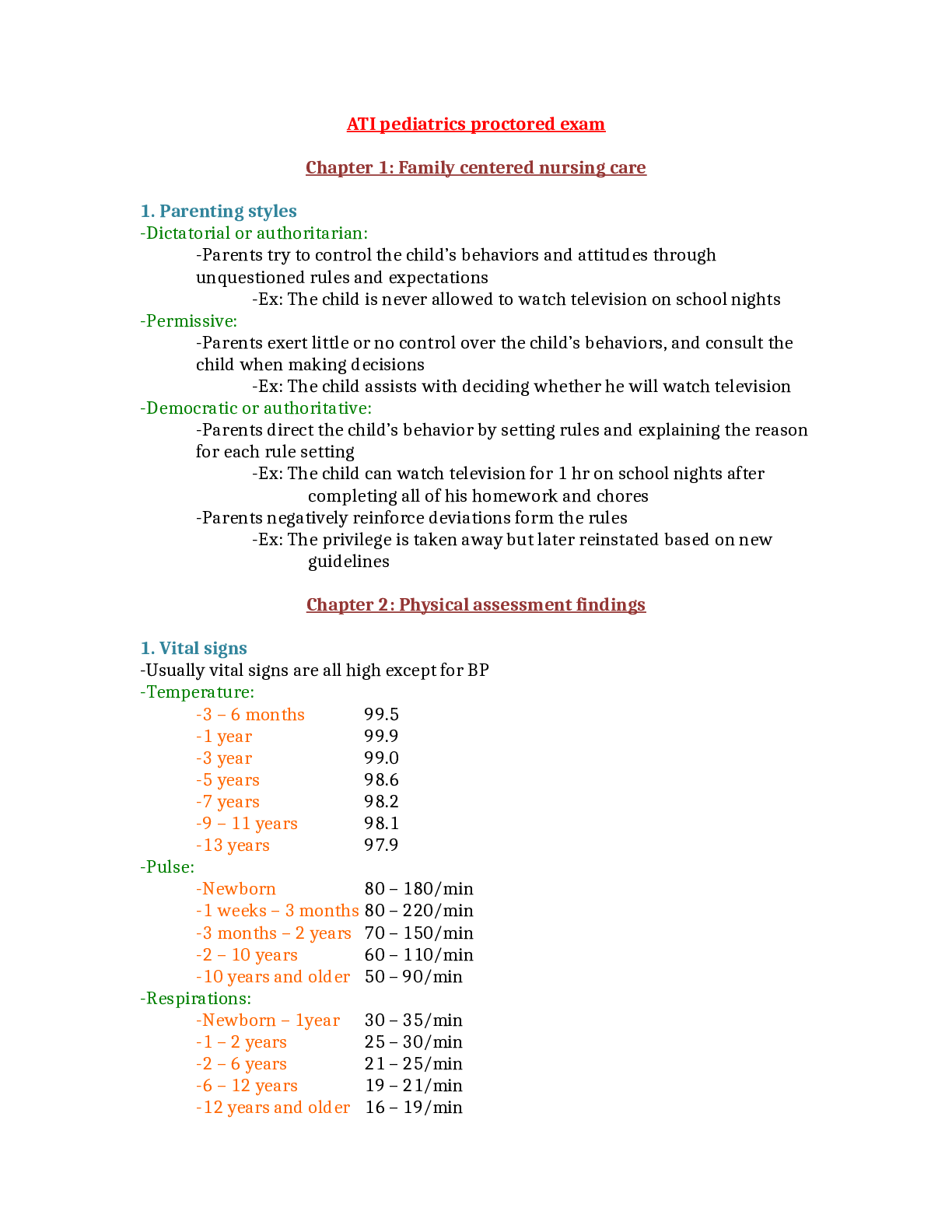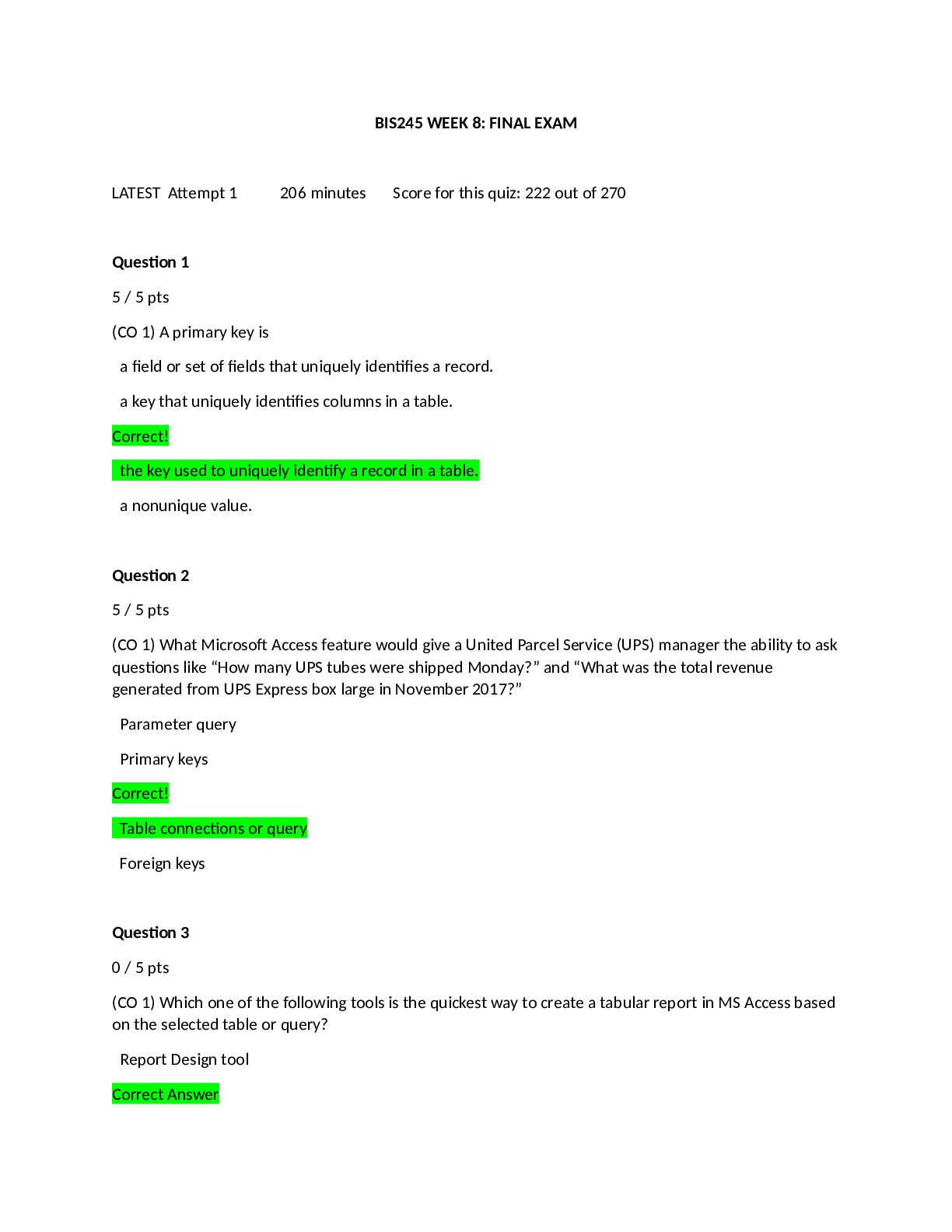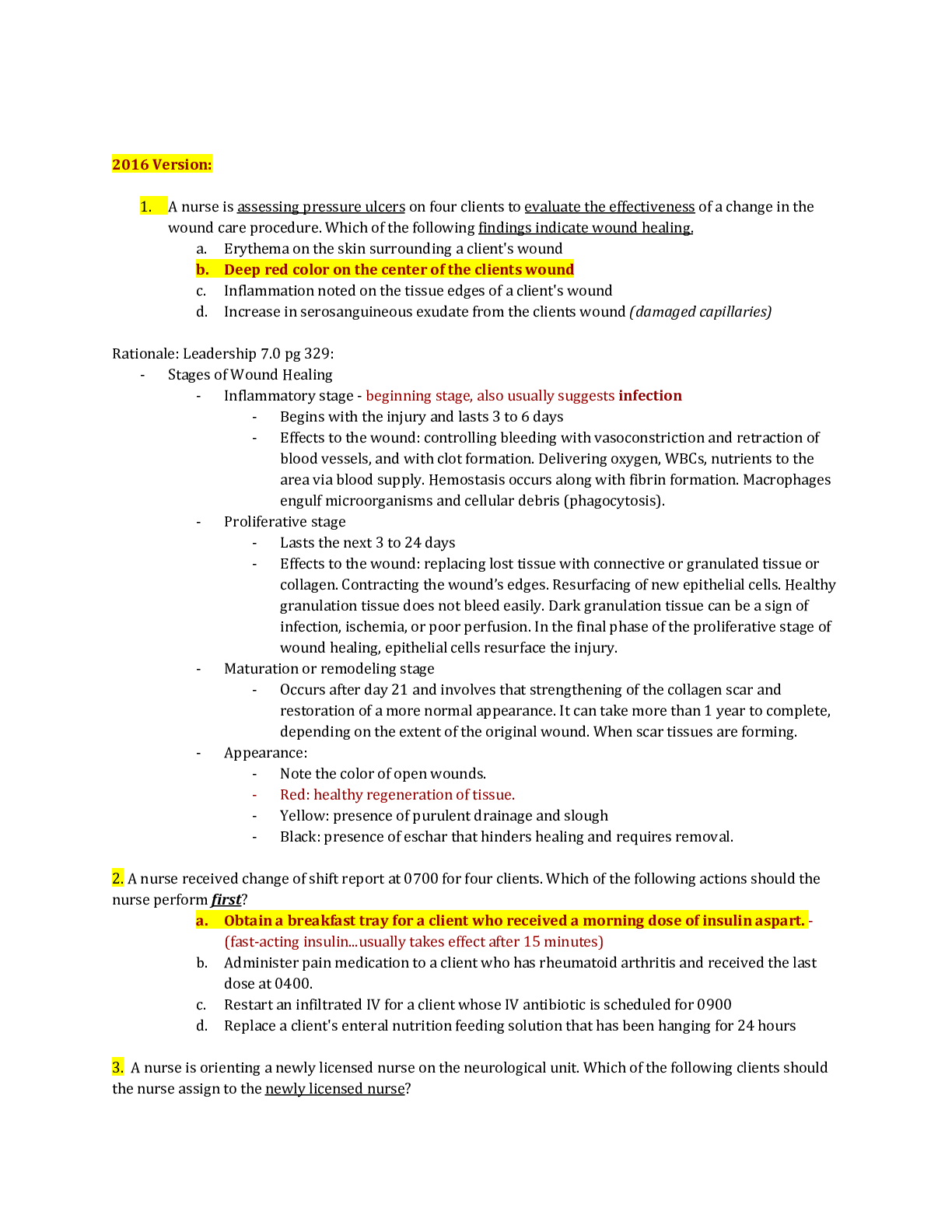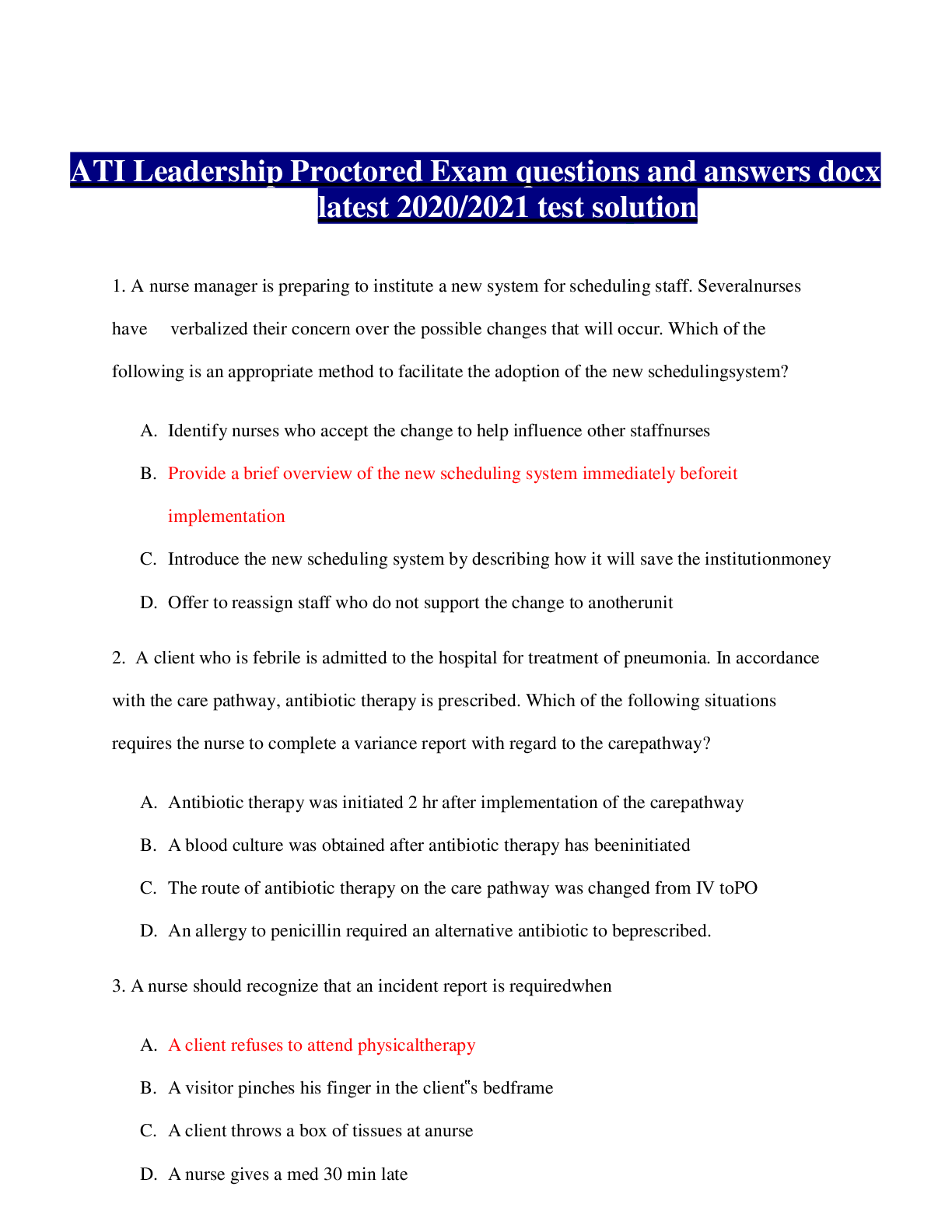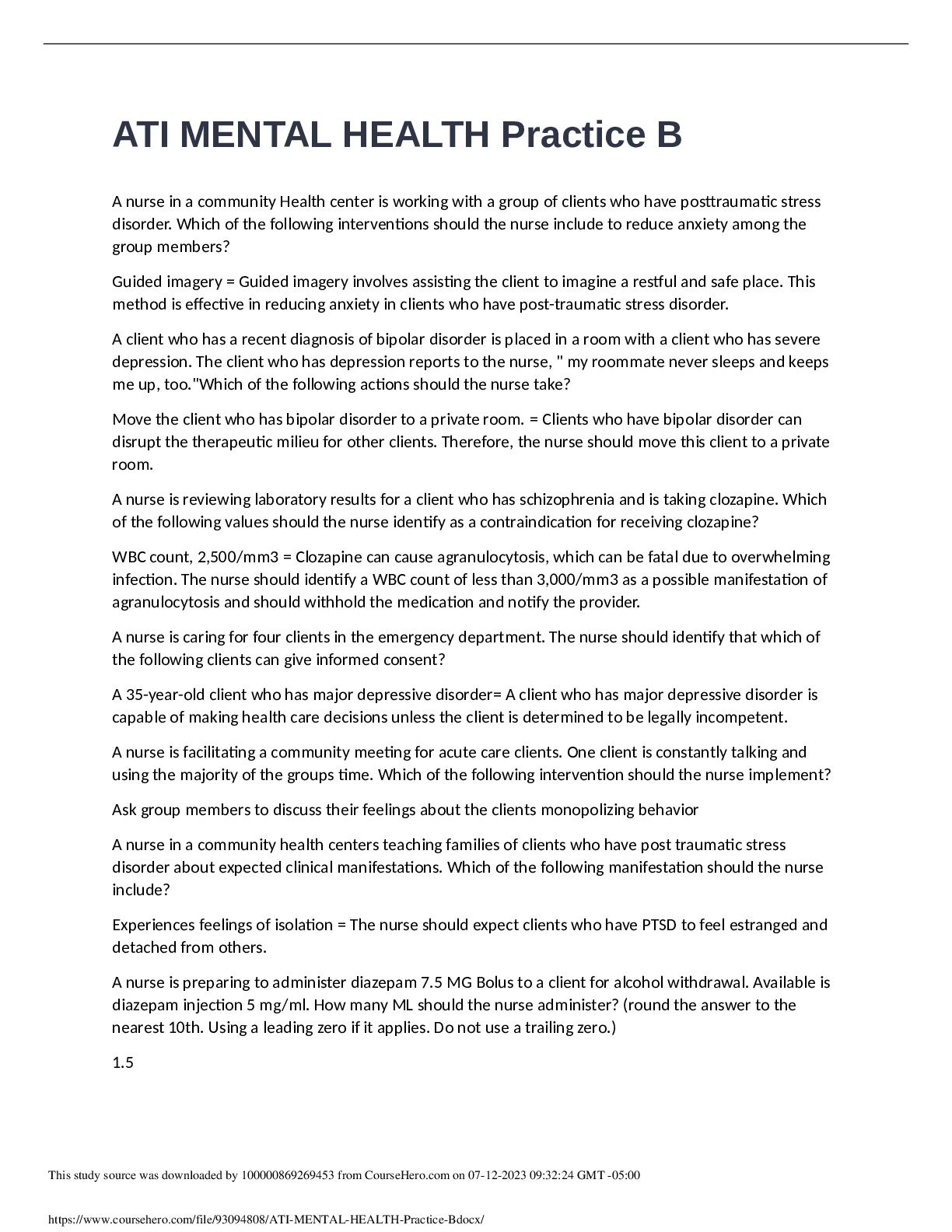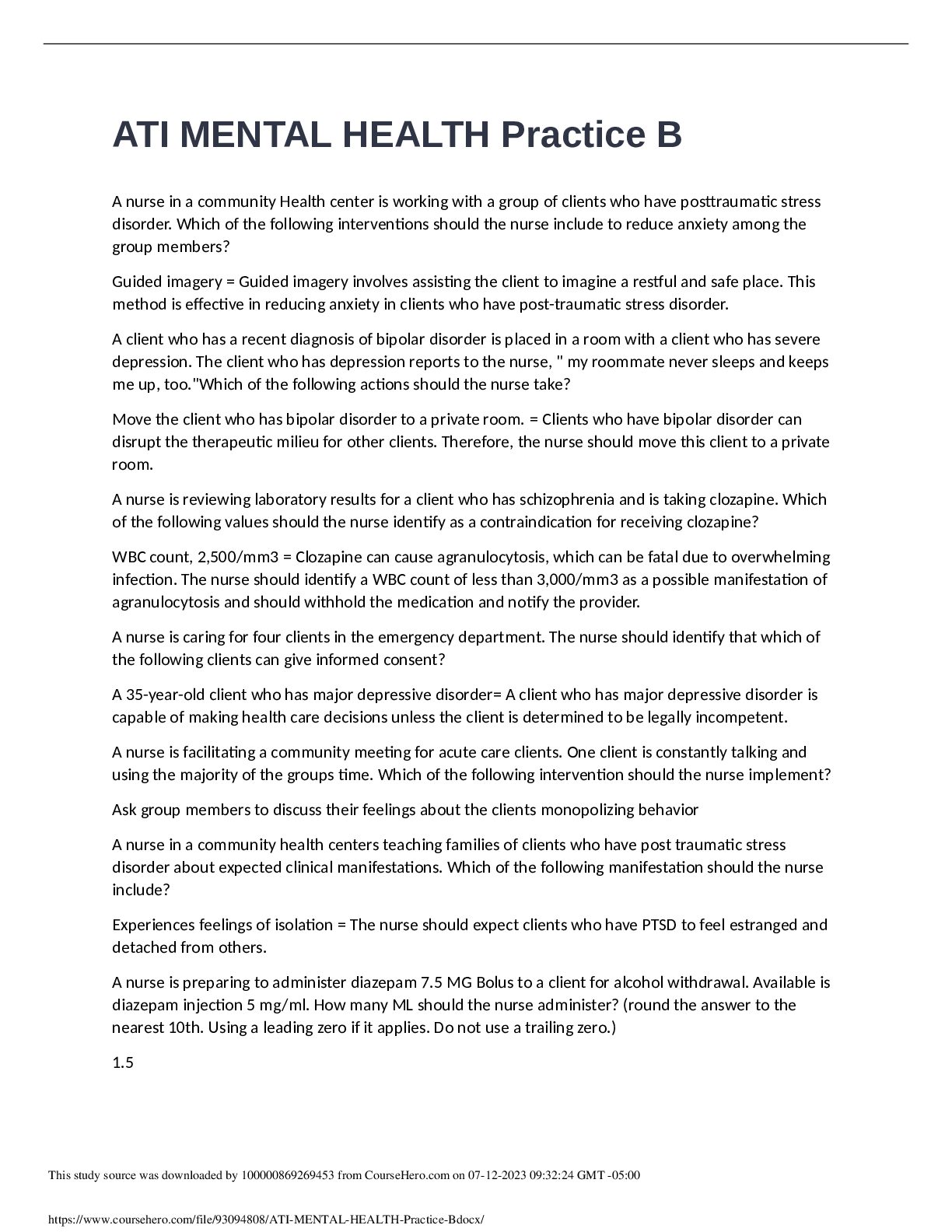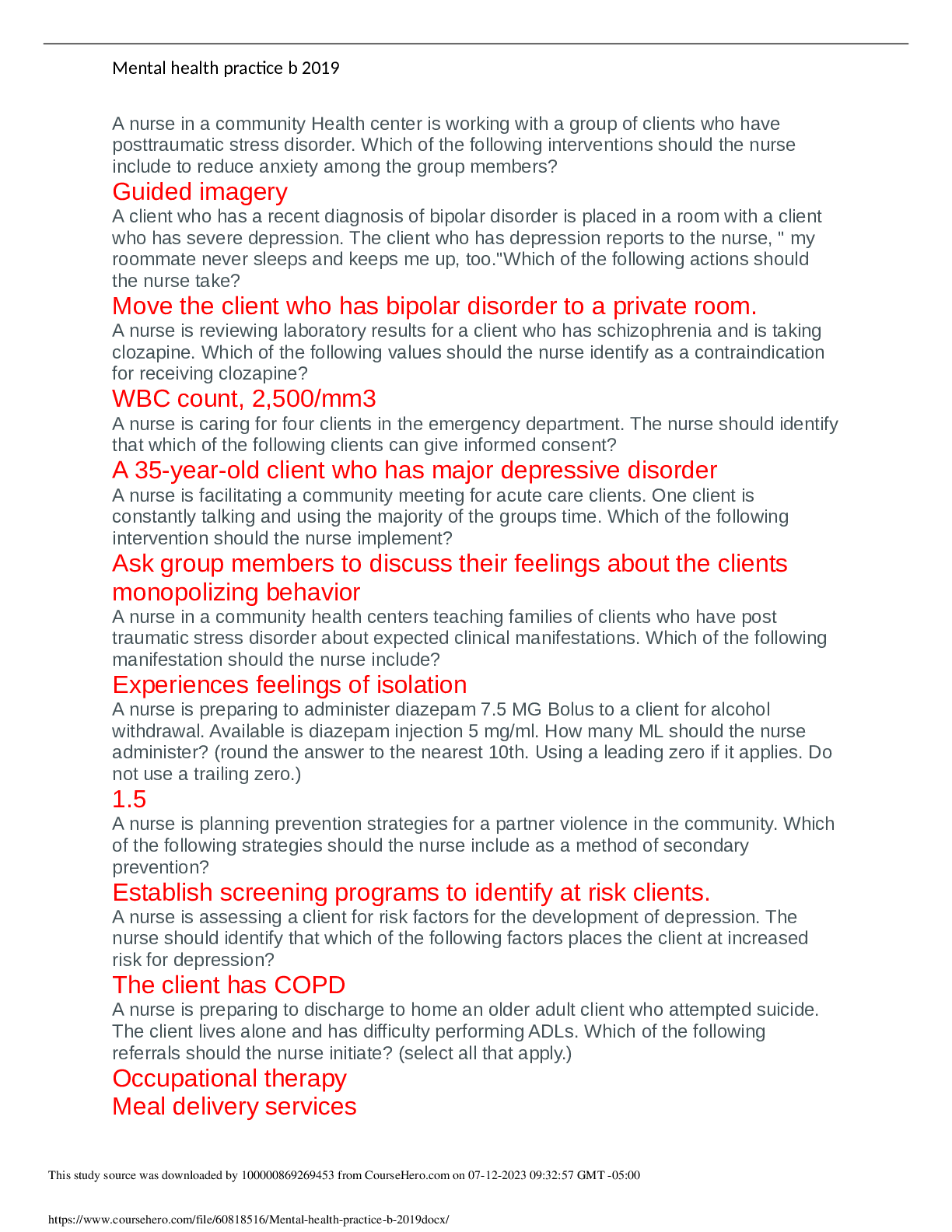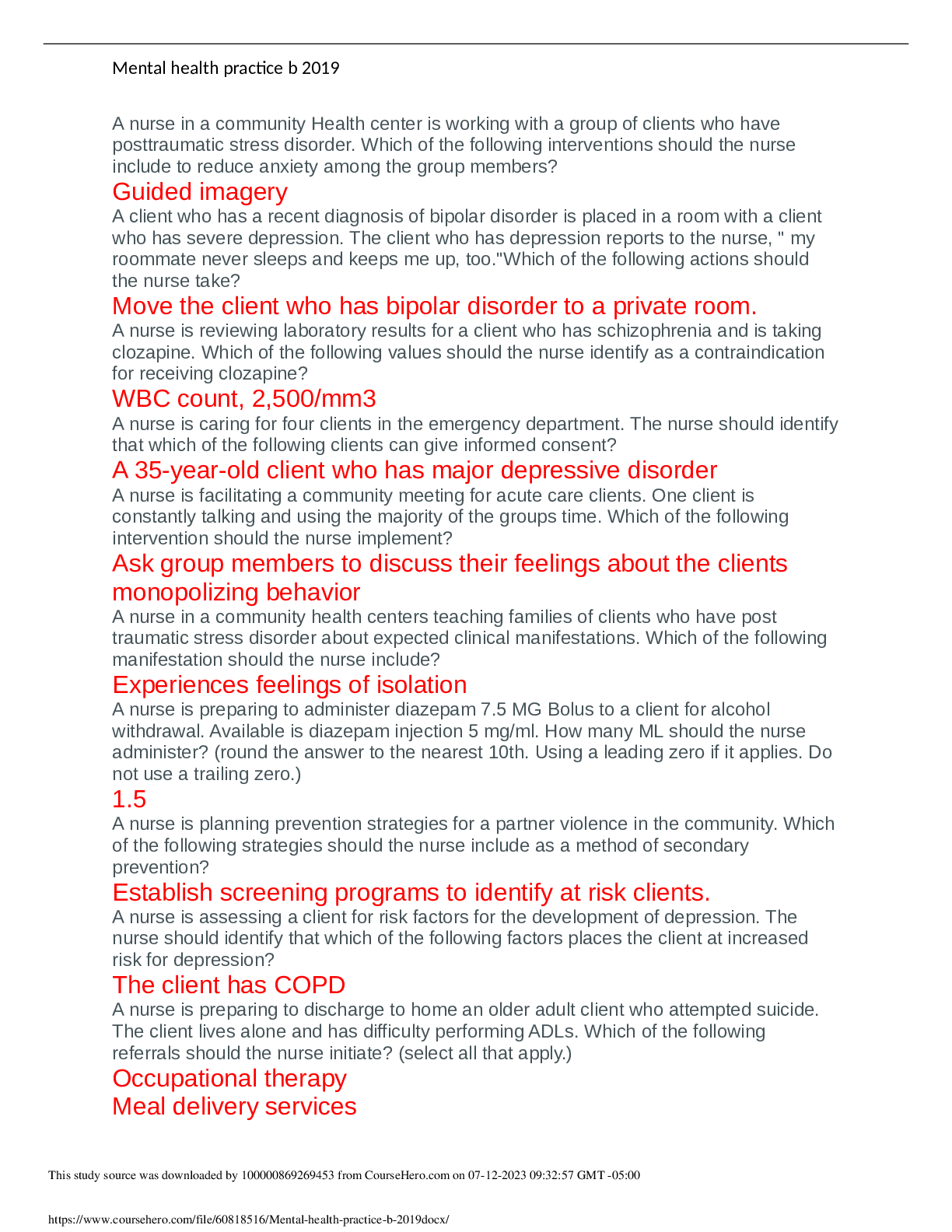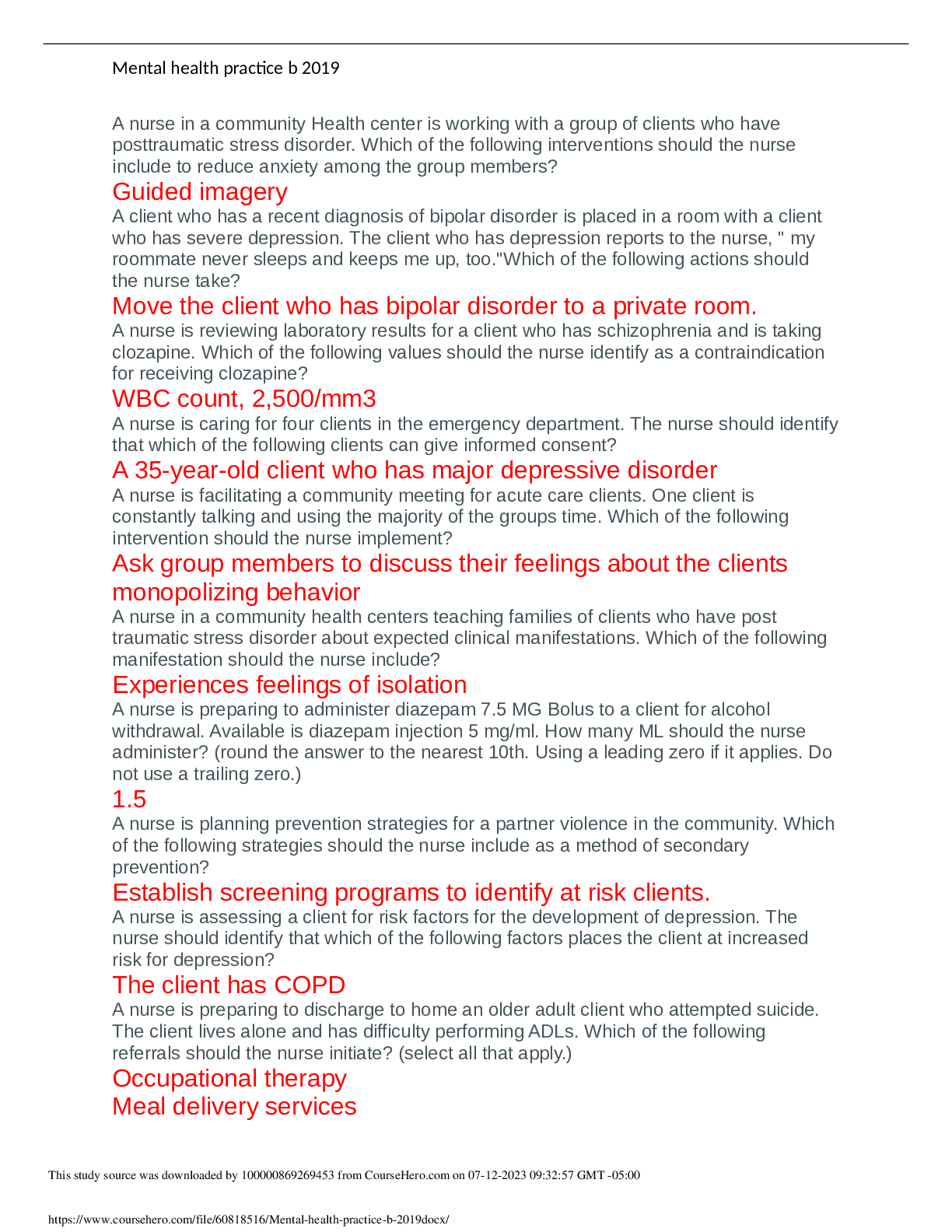*NURSING > EXAM PROCTORED > ATI Mental Health Practice B Latest 2022 50 Questions, Answers & Rationales (All)
ATI Mental Health Practice B Latest 2022 50 Questions, Answers & Rationales
Document Content and Description Below
ATI Mental Health Practice B Latest 2022 50 Questions, Answers & Rationales A nurse is reinforcing teaching to a client who has a new prescription for phenelzine. The nurse should instruct the clie... nt that eating foods high in tyramine can cause which of the following adverse reactions with this medication? A. Hypertensive crisis B. Serotonin syndrome C. Hearing loss D. Urinary incontinence - A. Hypertensive crisis RAT: Tyramine can cause severe hypertension in clients who are taking phenelzine, a monoamine oxidase inhibitor. Manifestations include palpitations, stiff neck, headache, nausea, vomiting, and elevated temperature. A nurse is contributing to the plan of care for a client who has antisocial personality disorder. Which of the following short-term goals should the nurse recommend be included in the plan? The client will participate in assertiveness training. The client will discuss feelings that cause hostility. The client will describe an activity they found enjoyable. The client will dress in a manner appropriate for the setting and temperature. - The client will discuss feelings that cause hostility. RAT: Clients who have antisocial personality disorder are frequently aggressive and are at risk for injuring themselves or others. A short-term goal for these clients should be to discuss feelings that precipitate aggression or hostility. The nurse is assisting with an admission have a client who has eating disorder. During data collection, which is the following to the nurse identify as manifestations of bulimia nervosa? SOAA. Tooth erosion B. Hand calluses C. Lanugo D. Amenorrhea E. Hypokalemia - A. Tooth erosion B. Hand calluses E. Hypokalemia RAT: Tooth erosion is a manifestation of bulimia nervosa that results from self-induced vomiting. Hand calluses are a manifestation of bulimia nervosa that results from self-induced vomiting. Lanugo is a manifestation of anorexia nervosa that results from starvation. Amenorrhea is a manifestation of anorexia nervosa that results from extreme weight loss. Hypokalemia is a manifestation of bulimia nervosa that results from volume depletion due to self-induced vomiting or excessive diuretic and laxative use. A nurse is caring for a client who is taking lithium and reports persistent nausea and vomiting for 2 days. Which of the following laboratory values should the nurse report to the provider? A. Potassium 4.0 mEq/L B. Lithium 0.9 mEq/L C. BUN 12 mg/dL D. Sodium 132 mEq/L - D. Sodium 132 mEq/L RAT: The nurse should identify that a sodium level of 132 mEq/L is not within the expected reference range of 136 to 145 mEq/L. This finding indicates hyponatremia, which can lead to lithium accumulation and places the client at risk for lithium toxicity. The nurse should report this finding to the provider. A nurse in a mental health unit is assisting with the plan of care for a newly admitted client who has anorexia nervosa. Which of the following actions should the nurse include in the plan of care? A. Weigh the client at night prior to bedtime.B. Offer liquid supplements to the client. C. Encourage the client to gain 2.3 kg (5 lb) per week. D. Observe the client for up to 30 min after meals. - B. Offer liquid supplements to the client. RAT: The nurse should offer liquid supplements to the client because the client might be unable to eat solid foods when they are first admitted. The nurse should observe the client for at least 1 hr after meals to prevent the client from throwing away, hiding, or purging food. A nurse is contributing to plan of care for a school-age child who has attention deficit hyperactivity disorder. Which of the following interventions should the nurse recommend? A. Avoid the use of humor when managing the child's disruptive behaviors. B. Instruct the child to apologize for behavior that negatively affects others. C. Maintain a scheduled plan of activities regardless of the child's behavior. D. Administer methylphenidate PRN when the child exhibits disruptive behavior. - B. Instruct the child to apologize for behavior that negatively affects others. RAT: The nurse should recommend performing simple techniques to manage the child's behavior, including making amends. This technique includes apologizing to others when the client's behavior has a negative effect. A nurse is reviewing laboratory values for a client who has anorexia nervosa. Which of the following results should the nurse expect? A. Potassium 3 mEq/L B. Phosphorus 3.5 mg/dL C. Magnesium 1.8 mEq/L D. Cholesterol 165 mg/dL - A. Potassium 3 mEq/L RAT: The nurse should expect a client who has anorexia nervosa to have hypokalemia, which is indicated by a decreased potassium level. This value is below the expected reference range of 3.5 to 5 mEq/L.A nurse is collecting data from a client who is experiencing alcohol withdrawal. Which of the following findings should the nurse expect? A. Elevated blood pressure B. Decreased heart rate C. Slurred speech D. Rhinorrhea - A. Elevated blood pressure RAT: Hypertension is an expected finding of alcohol withdrawal and can occur within 4 to 12 hr of cessation of alcohol ingestion. A nurse is caring for a client who recently lost their child in a motor-vehicle crash. The client is expressing feelings of hopelessness. Which of the following questions is the most important for the nurse to ask? A. "Are there times when you feel more upset than others?" B. "Have you had any thoughts of harming yourself?" C. "What type of support system do you currently have?" D. "During difficult times in the past, what did you do to cope?" - B. "Have you had any thoughts of harming yourself?" RAT: The greatest risk to this client is self-injury due to suicide. Asking whether or not the client has plans to hurt themselves is the most important question for the nurse to ask at this time because a positive response can alert the nurse to the need for suicide precautions and intervention. A nurse is reviewing the medical record of a client who has schizophrenia. For which of the following findings should the nurse withhold the client's medications and notify the provider? A. Fasting blood glucose B. Temperature C. WBC count D. Heart rate - C. WBC count [Show More]
Last updated: 2 years ago
Preview 1 out of 20 pages
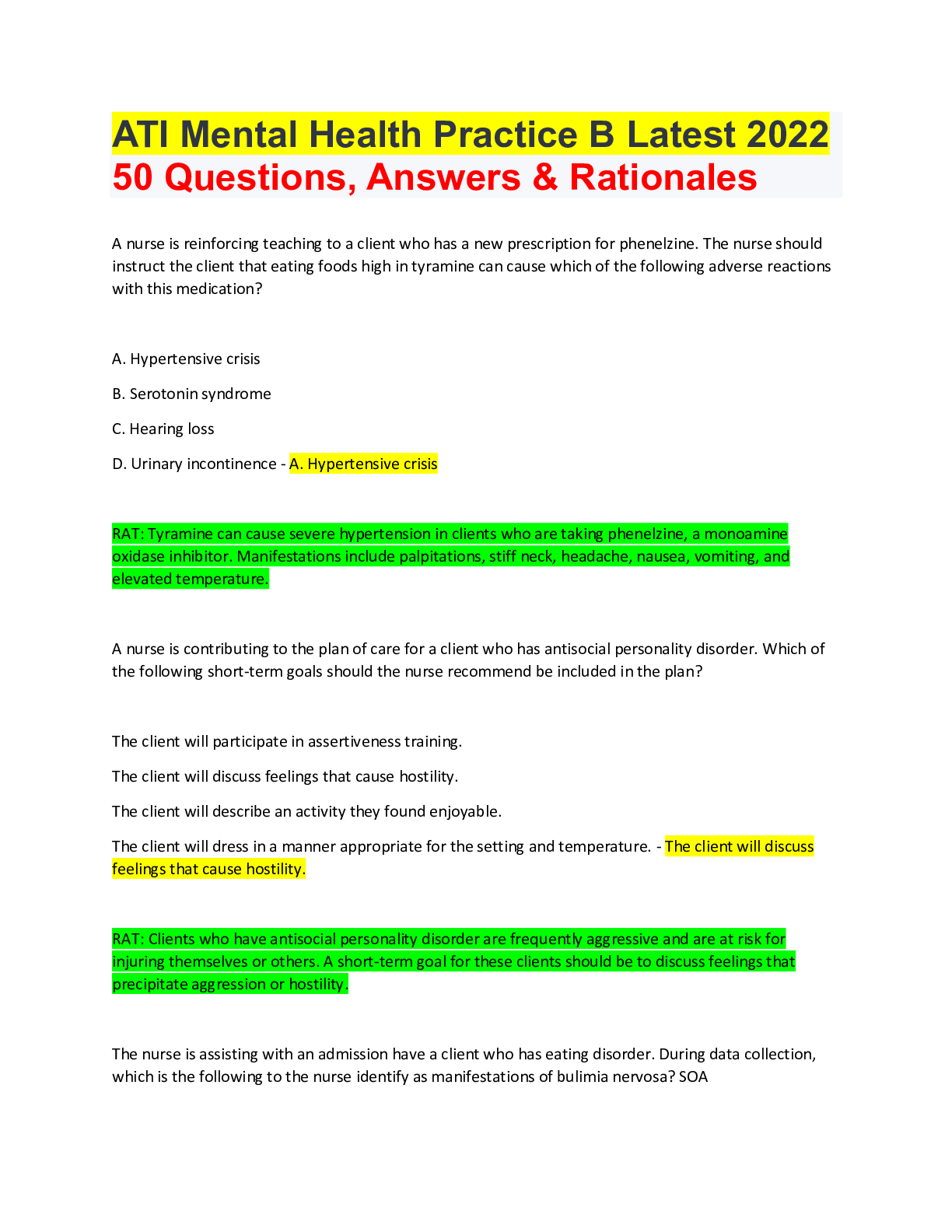
Buy this document to get the full access instantly
Instant Download Access after purchase
Buy NowInstant download
We Accept:

Reviews( 0 )
$11.00
Can't find what you want? Try our AI powered Search
Document information
Connected school, study & course
About the document
Uploaded On
May 02, 2022
Number of pages
20
Written in
Additional information
This document has been written for:
Uploaded
May 02, 2022
Downloads
0
Views
115

